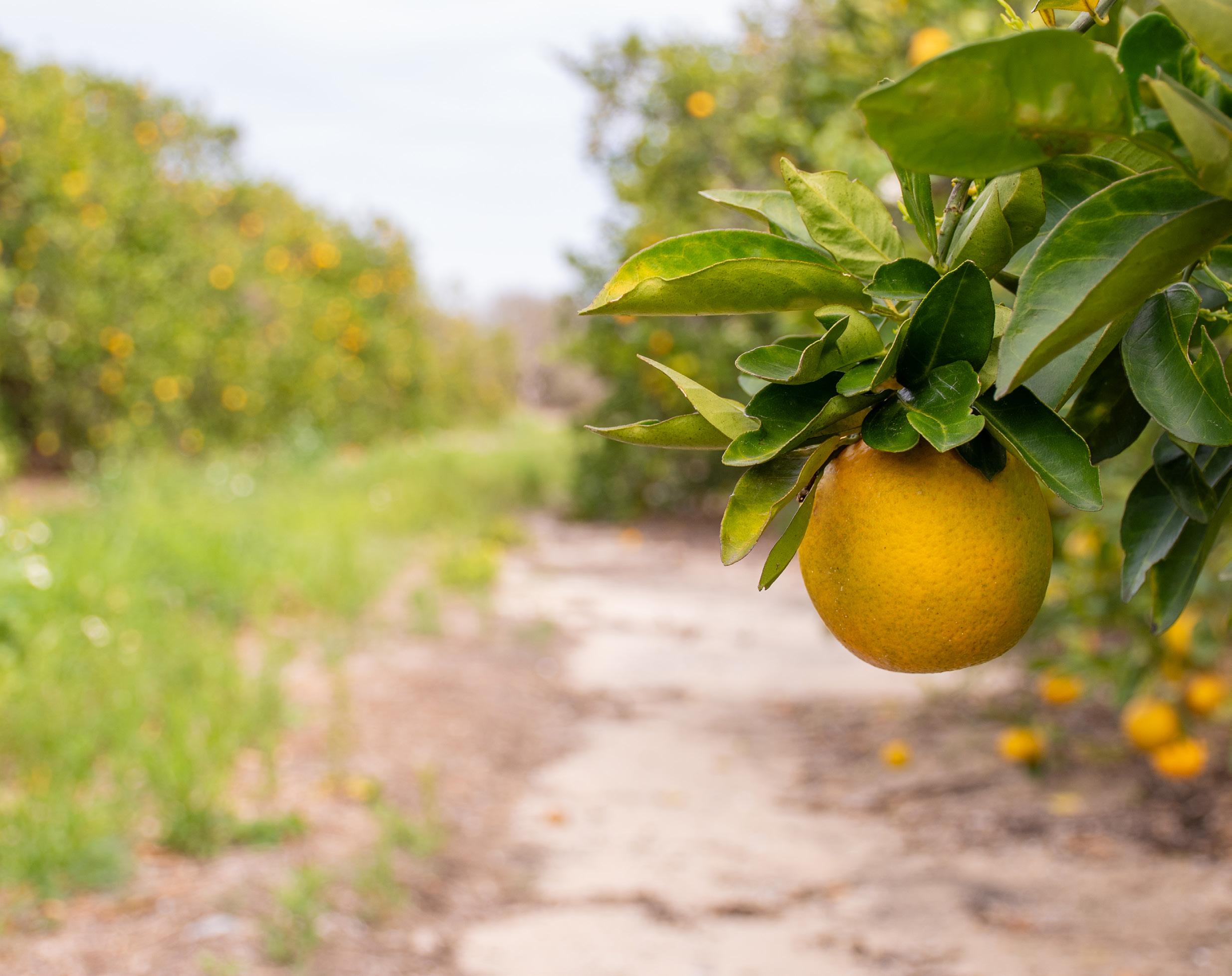




In the late 1800s, a series of devastating freezes struck the Florida citrus industry, which at the time was rooted in the more northern parts of the state. It had long been known that citrus was vulnerable to cold weather, but practical limitations—especially in transportation—made growing citrus further south difficult. There simply wasn’t an efficient way to move fruit from those warmer, more remote regions to consumers up north.
That began to change with the expansion of the railroad. As rail lines pushed further into the southern parts of the state, new opportunities emerged. Not only was the industry rejuvenated, it was reimagined—and Florida’s citrus production flourished into a global powerhouse. But it wasn’t just innovation in infrastructure that drove this growth. It was the determination and adaptability of Florida’s citrus growers, who embraced new ways of farming in unfamiliar territory.

The rich, loamy soils of the north gave way to the sandy, nutrient-poor soils of the south, and with that came new challenges in managing water and fertility. Those challenges sparked the creation of the University of Florida’s first off-campus research center, known at the time as the “Citrus Research Station.” Over time, UF’s dedication to citrus research included expanding citrus research programs to other regions around the state including the Indian River Research and Education Center, the Southwest Florida Research and Education Center and most recently a new commitment to serve the “Cold-Hardy” citrus growers of north Florida through faculty programs located at the North Florida Research and Education Center. Across these UF/IFAS Research and Education Centers (REC), scientists and Extension specialists are tackling regionspecific challenges, all while contributing to a broader, statewide understanding of citrus production.
Because Florida’s citrus research is now more geographically dispersed than ever, it can be difficult to keep track of where the latest, most relevant information is coming from. That’s where this new publication comes in. As UF/IFAS researchers, we’re not just generating knowledge—we’re committed to delivering it in practical, accessible ways that serve you, the growers who keep this industry moving forward.

The UF/IFAS Citrus Magazine is a new Extension initiative designed to bridge that gap. You can expect three editions each year, featuring articles written by UF/IFAS citrus scientists and Extension faculty across the state. Our focus is on research you can use—tools, strategies, and insights that can help improve your operation today. We’ll also spotlight promising research that’s on the horizon, so you’ll be among the first to know what’s coming and how it might benefit your groves.
This magazine will be available in both print and digital formats, so whether you prefer a copy on your desk or reading from a mobile device, we’ve got you covered.
We’re excited to bring this to you— and more is on the way. In the coming months, we’ll be launching additional outreach efforts to make sure you stay connected to the latest research and Extension support. Because ultimately, everything we do is driven by your success in the field.
Welcome to the first issue of UF/ IFAS Citrus Magazine. We hope you find it informative, timely, and helpful as we continue working together to build a more resilient citrus industry.

Michael E. Rogers UF/IFAS Statewide Citrus Research and Extension Coordinator

In the fall, we receive ample rainfall from September to mid-October, after which we enter our dry period. Consequently, citrus trees continue to grow through September, followed by a significant slowdown by December. Meanwhile, the fruit is actively growing, progressing through fruit maturation, and color change. Therefore, horticultural and pest management are critical in this period. This time is crucial for improving fruit quality, managing diseases, and supporting overall good tree health.
Credit: UF/IFAS
• Fertilize to promote fruit development and quality
• Irrigate to enhance fruit quality and reduce fruit drop
• Apply GA and 2,4-D to support fruit development and reduce fruit drop
• Scout for disease symptoms
• Focus on postharvest fruit handling and decay prevention
• Continue insect, mite, and snail management, especially if the weather stays warm
• Regularly scout and monitor pest populations
READ. APPLY. GROW.
Page 6
Horticultural Grove Management
Page 8
Individual Protective Covers
During Hurricane Season
Page 9
Insect, Mite, and Snail Management
Page 12
Disease Management
Page 15
The Millennium Block: A Testament to the Ingenuity and Resilience of Citrus Crops
Page 18
Plant Growth Regulators Work Together to Reduce Fruit Drop
Page 22 Will Actual Production History Continue to be Beneficial in the Future?

Editorial Committee
Ute Albrecht
Michelle Danyluk
Megan Dewdney
Lauren Diepenbrock
Mark Ritenour
Michael Rogers
Ariel Singerman
Matt Smith
Tripti Vashisth
Editorial Jamie Burrow
Graphic Designer Tonya Weeks
UF/IFAS Citrus Research
https://citrusresearch.ifas.ufl.edu
Contact us at citrusresearch@ifas.ufl.edu
Tripti Vashisth, Davie Kadyampakeni, Fernando Alferez, Ute Albrecht, Flavia Zambon, and Muhammad Shahid
From September to December, the primary activity of citrus trees are fruit growth and maturation. Most citrus varieties are in stage 2 (fruit growth development) during September, transitioning into the maturation stage from early to late fall. This period is critical, as fruit quality is largely determined during this time. Final fruit size and sugar accumulation are achieved within this window, making it essential to implement production practices that optimize fruit quality.
For early- and mid-season varieties, significant fruit drop can occur during this period. Applying the appropriate plant growth regulators at the correct time is therefore crucial to minimizing fruit loss.
November and December are also key months for flower bud induction. Any strategies aimed at influencing return bloom should be carried out during this timeframe.
This section will discuss important horticultural management strategies for this period. For detailed guidance, please refer to the Florida Citrus Production Guide.
In most of the Florida peninsula, September and October typically bring ample rainfall, making supplemental irrigation less critical during these months. However, rainfall decreases significantly in November, and prolonged dry periods often occur. If daily average temperatures remain above 75 °F, citrus trees require supplemental irrigation to avoid drought stress. Irrigating every 2-3 days is generally sufficient to maintain soil moisture above 30%.

Microsprinkler irrigation.
Drought stress not only reduces photosynthesis in the leaves but can also increase pre-harvest fruit drop, cause off-season or prolonged flowering, and, in severe cases, lead to defoliation. Minimizing water deficits is therefore essential. Emerging evidence suggests that the number of leaves on a fruiting branch directly influences fruit °Brix and size, meaning adequate water availability may indirectly improve fruit quality.
While experience or a simple calendar-based approach can provide a reasonable irrigation schedule, these methods are not accurate enough to maximize water-use efficiency or prevent nutrient leaching. Calendar-based scheduling involves obtaining daily evapotranspiration (ET) from sources such as the Florida Automated Weather Network (FAWN) at https://fawn.ifas.ufl.edu The daily ET is multiplied by a crop coefficient (Kc), which varies by time of year, to estimate daily water loss. This value is then subtracted from the previous
day’s soil moisture estimate to determine irrigation needs.
Reference ET data and user-friendly irrigation scheduling tools for all Florida citrus production regions are available on the FAWN website. For more detailed guidance, consult the Florida Citrus Production Guide.
From September to December, citrus trees have relatively low nutrient demands. Fertilizer applications after SeptemberOctober (depending on variety) are generally not recommended. Avoiding fall fertilizer application beyond October is critical for ensuring optimal fruit development and harvest quality.
High nutrient levels, especially nitrogen, during the fruit maturation phase can delay proper color break and reduce °Brix at harvest, which compromises fruit quality and marketability. Poor color development and low °Brix can reduce fresh-fruit pack-out rates and may force delayed harvesting, increasing the risk of pre-harvest fruit drop, particularly in HLB-endemic groves. In addition, fall or winter fertilization can hinder psyllid control and increase the likelihood of freeze injury.
To maximize fruit quality and minimize risks, the final split nitrogen application should be made in September for early- and mid-season varieties and by October
for late-season varieties. Regular leaf sampling during maturation, aiming for tissue nitrogen levels of 2.2% to 2.4%, helps ensure optimal peel color and fruit quality. Following this timing not only promotes healthier trees but also improves harvest outcomes and market success.
Potassium is also essential for fruit development and quality, but its application timing differs from that of nitrogen. In spring, during bloom and fruit set, potassium demand is relatively low. Requirements increase in summer and early fall, when potassium supports cell division, fruit enlargement, and maturation. High potassium fertilizers are recommended during these warmer months with approximately 60-75% of annual potassium applied in late summer and early fall. Latematuring varieties such as ‘Valencia’ can benefit from potassium applications in October.
For the rest of the essential nutrients, about 25% of the annual fertilizer should be applied in SeptemberOctober. Fertilization in November-December is not recommended, as low soil temperatures may reduce nutrient and water uptake, young flushes are more susceptible to freeze injury, and peel color may be negatively affected.
Plant Growth Regulators (PGR)
September to December is a critical period for both gibberellic acid (GA) and 2,4-dichlorophenoxyacetic acid (2,4-D) applications.
Gibberellic acid (GA): Monthly GA applications from September to January on ‘Valencia’ have been shown to:
• Increase yield by an average of 30%
• Reduce fruit drop
• Improve canopy growth
• Enhance plant defense responses
These benefits are likely due to the timing of applications, which coincide with the floral induction period and influence fruit growth.
To improve canopy, productivity, and yield, multiple GA applications are required, spaced 30-45 days apart, at a rate of 20 grams active ingredient per acre with a nonionic surfactant. Applications can begin in July and should continue based on variety:
• Late-maturing varieties: Apply until the end of December.
• Early- and mid-season varieties: Stop after October to avoid prolonged intense green peel color.
GA does not reduce juice °Brix but does slow peel and fruit senescence. For best results, allow at least a 2-month interval between the last GA application and harvest.
However, a single GA application is not effective in rebuilding the canopy of HLB-affected sweet oranges, multiple GA applications are still required for that purpose.
2,4-dichlorophenoxyacetic acid (2,4-D): A synthetic auxin analogue that reduces pre-harvest fruit drop by suppressing abscission by counteracting ethylene perception in fruit tissues. Because timing is critical, applications must be made before fruit drop begins.
For sweet oranges, apply 2,4-D (Citrus Fix) at 3.2 ounces per acre during November-December to reduce pre-harvest fruit drop.
Combined GA and 2,4-D applications: Recent research indicates that a single combination spray of GA and 2,4-D can act synergistically to reduce pre-harvest fruit drop, including losses after hurricanes.
The developmental stage of the fruit and the timing of injection can affect both fruit quality and oxytetracycline (OTC) residues. To prevent residue levels from exceeding the maximum residue levels (MRL) permitted for OTC in fruit, do not inject citrus trees from September through December.
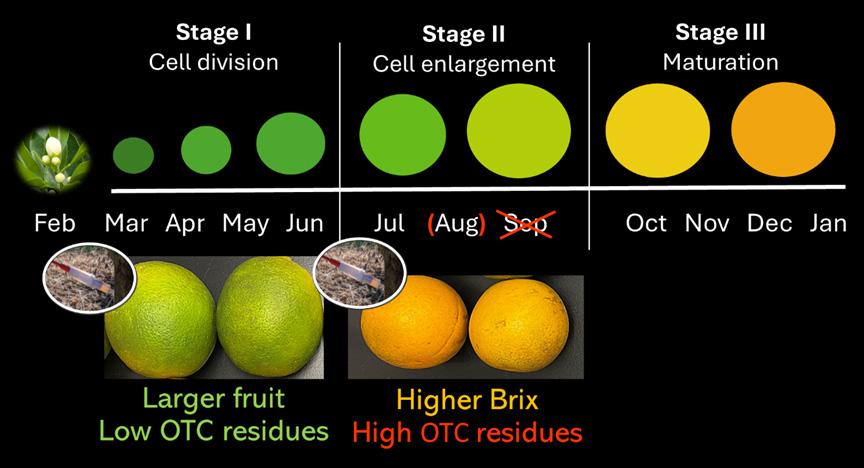
Do not inject citrus trees from September through December.
Credit: Ute Albrecht, UF/IFAS

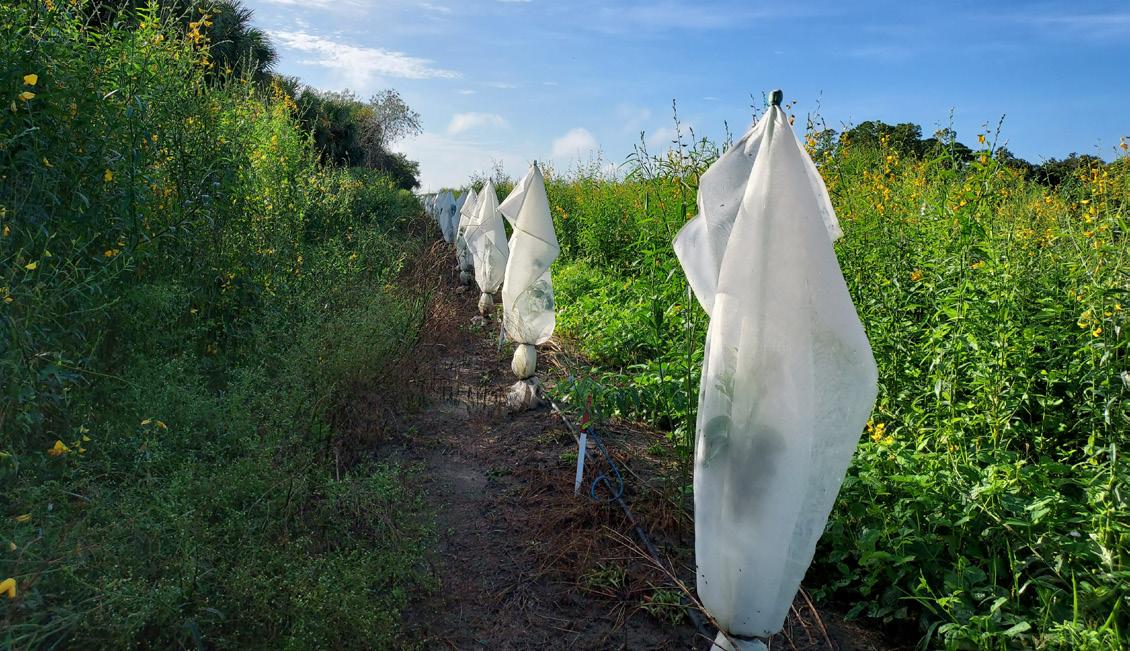
When installing individual protective covers (IPC), particularly on the youngest trees, securing them with zip ties at the bottom can help keep them in place. Being blown off is the most common hurricane-related issue for IPCs. Without zip ties, covers attached only at the top of PVC poles may shift or become displaced, leaving trees exposed to psyllids.
The extent of displacement depends on wind conditions in the grove. For example, during Hurricane Helene, wind gusts reached 50 mph at the UF/IFAS Southwest Florida Research and Education Center (SWFREC) in Immokalee. Even under those conditions, fewer than 10% of covers were displaced, and none were completely blown away (Figure 1).
Based on these observations, it appears it is better to use zip ties, at least for newly planted trees. However, if flooding occurs, zip tying IPCs may worsen flooding stress on roots. Research has shown that trees with zip tied IPCs have a lower vapor pressure deficit compared to trees with loose-bottom IPCs, resulting in reduced evaporation. This may limit the tree’s ability to relieve flooding stress on the roots.
One way to address this dilemma, whether to tie or not to tie, is through the use of row middle plantings. A citrus grower in Hendry County, for example, has been using sunnhemp in the row middles and reported no IPCs losses or displacement during Hurricane Helene (Figure 2), along with improved flood management, even though the trees were zip tied.
Get to the grove as soon as it is safe to do so and check trees for IPC loss or partial exposure. In many cases, especially if the area did not take a direct hit, the IPCs will still be attached to the PVC poles, but the tree may be exposed (Figure 1). In these situations, the covers will need to be repositioned.
If trees remain uncovered for several days after a hurricane (for example, if flooding or other conditions prevent immediate access), mark or record the location of exposed trees. Then, scout for psyllids, apply an insecticide, and consider collecting leaf samples before replacing the IPCs so the samples can later be tested for huanglongbing (HLB) in a lab.
After any hurricane, inspect IPCs for damage and replace damaged IPCs as soon as possible. It is a good idea to keep some spare IPCs in storage for emergencies.
If flooding has occurred and IPCs were zip tied, it is recommended to untie the bottoms after the hurricane. This allows vapor pressure deficit inside the IPC to equal that of the outside atmosphere, increasing transpiration and helping prevent root damage caused by excess water.
Lauren Diepenbrock
In most of North America, pest populations decline with cooler temperatures and plant dormancy. However, Florida’s climate and plants don’t play by these “rules.” Insect, mite, and snail management often must continue throughout the fall and winter. Tropical weather can further complicate pest control by creating favorable conditions for many pests to thrive.
The following is a list of common citrus pests, their typical seasonal activity, and corresponding management needs. For recommended management practices, refer to the most recent edition of the Florida Citrus Production Guide.
2025 has been a very different year for Bulimulus activity in citrus groves. In previous years, both May and June were quite hot and dry, and snails could be found encrusting irrigation emitters, feeding on foliage, and covering the trunks of many trees. This year, however, prolonged rainfall has reduced visible pest pressure compared to prior seasons.
Unfortunately, reduced visible damage does not reflect actual population levels. Trapping data indicate that within-field snail populations have been much higher this season than in past seasons. When a dry spell occurs, as often happens in the fall, snail activity is likely to surge, potentially requiring management inputs. While formal recommendations are not yet available, our team is actively evaluating baits and various pesticides for snail control.
Asian citrus psyllid (ACP) populations typically peak during spring and mid-summer flushes, but a late flush in September can cause numbers to rise again. If your groves experience a September flush, consider applying an insecticide to reduce ACP impact.
Citrus leafminer (CLM) are present year-round in or near groves and quickly take advantage of flush when it is available. While they do not transmit pathogens like ACP, their feeding reduces leaf surface area and creates small tears in the tissue. These injuries provide easy entry points for the citrus canker pathogen. Because CLM are attracted to flush for egg-laying, it would be prudent to time insecticide applications to protect newly developing leaves.


Citrus rust mites (CRM) thrive in hot, dry conditions, which often occur in the fall. During this time, rust mite numbers can increase rapidly. If CRM feeding damage is a concern, then management for this pest needs to be included in your fall spray plans.
Significant rainfall events are associated with Diaprepes root weevil (DRW) adult emergence. The first major emergence generally occurs with the spring rains and slowly continue to emerge over time. Occasionally a second emergence peak may occur between late August and mid-October. If this happens, additional management actions may be warranted.
Lebbeck mealybug populations often rise in the fall after a temporary decline during late summer’s high heat and low moisture. If your groves are affected by lebbeck mealybug, a fall treatment can help reduce populations before winter and lower the starting pressure in spring. In late fall, most of the lebbeck mealybug population will be comprised of juveniles stages, which are the easiest stage to control with insecticides.
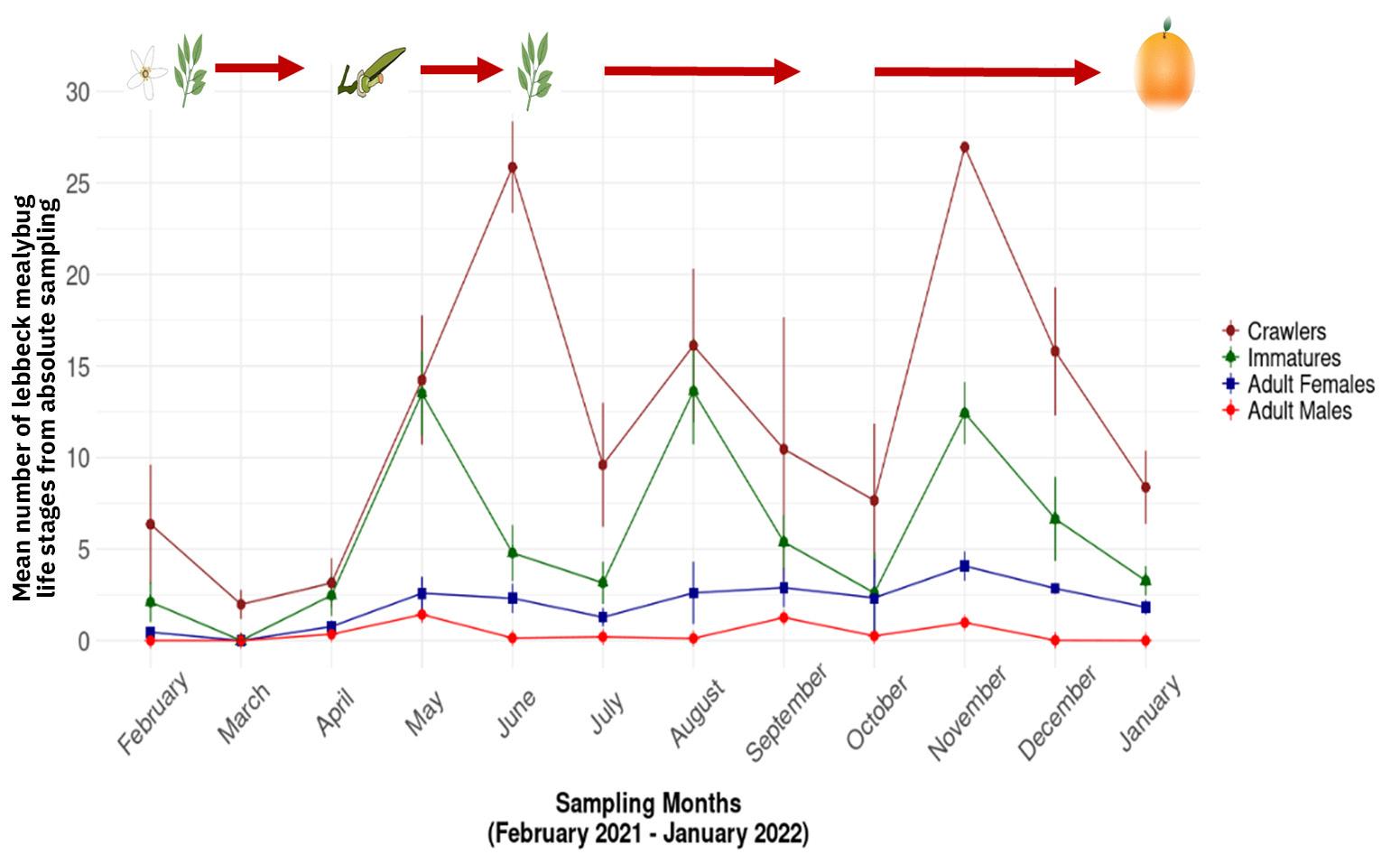
Ramdas Kanissery
Dayflowers are fast-growing annual weeds in the Commelinaceae family, including aggressive species such as Asiatic dayflower, spreading dayflower, and tropical spiderwort. They are commonly found in Florida citrus groves and spread quickly by rooting at the stem nodes. These weeds thrive in moist, shaded spots like citrus tree rows, where they can quickly spread and become tough to control if not caught early.

• Scout early and regularly: Inspect tree rows often, especially in damp or shaded spots where dayflowers tend to get established.
• Prevent the spread: Dayflower stems can easily re-root if left on the ground. Clean spraying and mowing equipment after working in infested areas to prevent spreading it to uninfested parts of the grove.
• Use the right post-emergence herbicides: For actively growing dayflower, use a systemic postemergence mix such as glyphosate combined with 2,4-D (e.g., Embed Extra). Contact herbicides such as glufosinate (Scout or Rely280) and carfentrazone (Aim) can be effective on young dayflower plants. Regrowth from roots is likely, so follow-up applications may be necessary.

• Know what products will not work: Although dayflowers are monocots, they are not controlled by grass-specific herbicides such as Fluazifop or sethoxydim.
• Plan ahead with pre-emergence herbicides: Products like flumioxazin (Chateau) and pendimethalin (Prowl) have shown good activity in reducing new dayflower emergence and should be included in an overall weed management program.
Dayflowers may look like delicate plants, but they are persistent and competitive weeds in citrus groves. A well-rounded management plan that includes early detection, equipment sanitation, effective herbicide use, and pre-emergence control can help keep this tough weed under control.

Dayflowers are named for their short-lived blooms, which typically last only one day.
Mark Ritenour and Megan Dewdney
From late summer to early winter, disease management concerns are generally fewer than at other times of the year. During this period, much of the focus shifts to postharvest fruit handling and decay prevention. However, it is also an ideal time to assess the season’s disease pressures and begin planning for the next year.
Ask yourself: Were there problem areas for specific diseases such as postbloom fruit drop (PFD) or Phytophthora root rot? Have your groves been included in new or expanded quarantine zones for citrus black spot? Conducting a quick scout can be helpful. Look for PFD buttons or diseased flowers on the off-season bloom to estimate inoculum levels in problematic blocks.
Citrus black spot symptoms are primarily seen on ripening or ripe fruit. If you are uncertain about the extent or severity of black spot in certain blocks, December can be a good time to scout, particularly if weather remains warm. Without a clear understanding of the issues present in your grove, it is difficult to make cost-effective disease management plans.
One potential concern during this period is brown rot in early-ripening cultivars. While most treatments for brown rot are applied before September, late-season management options include Revus and Orondis Ultra (see Florida Citrus Production Guide for details).
Finally, consider protecting your fall root flush from Phytophthora root rot in areas with sufficient inoculum levels to warrant treatment.
Compared to 20 years ago, handling fresh citrus fruit during the early season presents greater challenges. While fruit may meet legal maturity standards, peel color often falls short of market requirements. Degreening treatments can improve peel color, but ethylene exposure can stress the fruit and increase fruit decay. Huanglongbing (HLB; citrus greening) further weakens trees and increases fruit susceptibility to decay. Thus, careful attention to degreening conditions, keeping degreening treatments as short as possible, and using the best practices to reduce decay are especially important during the early months of the harvest season.
Temperature: Maintain 82-85 °F. Never allow fruit to warm above this range, as higher temperatures accelerate deterioration. Higher or lower temperatures especially delay orange coloration, though grapefruit tolerate slightly cooler temperatures without slowing coloration much. If the fruit color is pale yellow after degreening, especially with mandarins, degreening at lower temperatures lengthens degreening time but enhances orange coloration.
Ethylene: Three to five parts per million (ppm) ethylene is adequate for degreening citrus.
Humidity: Maintain relative humidity (RH) between 90%-95%.
Ventilation: A fresh air exchange rate of one air change per hour is recommended to prevent carbon dioxide (CO2) accumulation to levels inhibiting degreening.
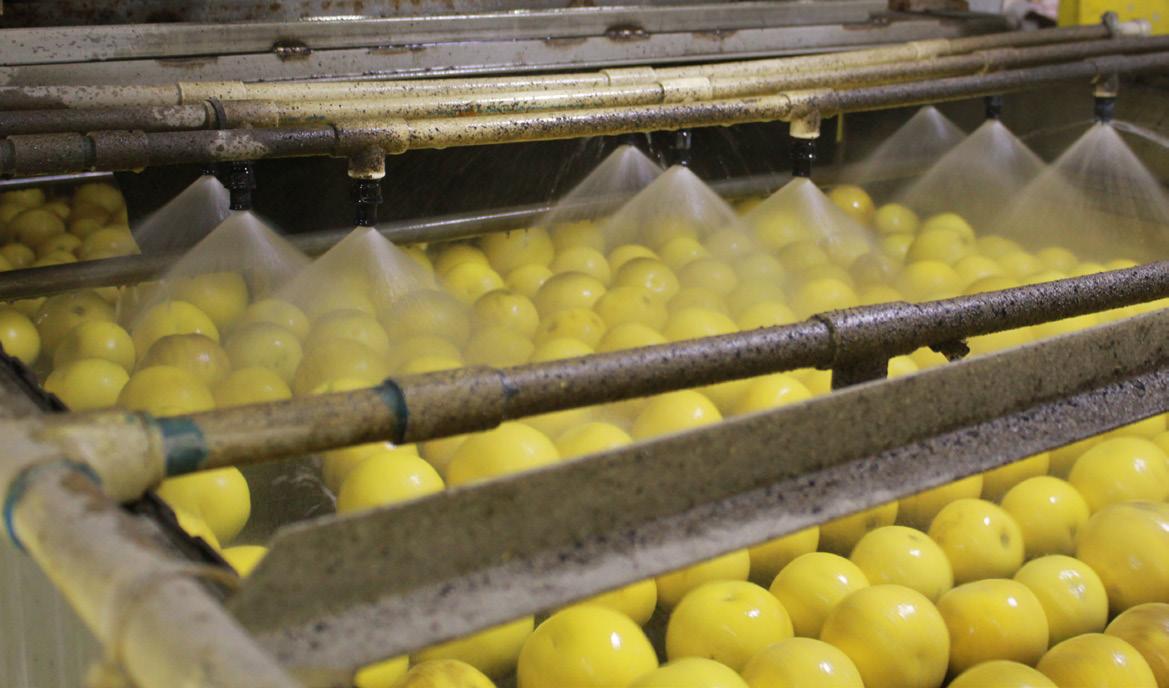
Air circulation: Maintain air movement within the room at a minimum of 10 cubic feet per minute (CFM) per field box (17 cubic meters per hour) or 100 CFM (170 cubic meters per hour) per pallet box to maintain uniform temperature within the load.
Best Citrus Fruit Practices to Minimize Fruit Decay Minimizing fruit injuries: Mechanical injuries to the fruit peel during harvest and handling creates infection sites for pathogens that cause green mold, blue mold, and sour rot.
Sanitation:
• Remove fruit, leaves, and debris from packinghouse floors and machinery daily.
• Decayed fruit should be separated from healthy fruit immediately after dumping on the packing line to prevent contamination of the line by fungal inoculum.
• Keep discarded decayed fruit away from the packinghouse to reduce airborne spores and insectborne spore spread.
• Sanitize fruit-contact surfaces with approved sanitizers (e.g., chlorine, peroxyacetic acid, etc.) or hot water (at least 160 °F) after cleaning at the end of each day.

Treat fruit with a labeled fungicide: Effective fungicides for Florida include thiabendazole (TBZ), imazalil, sodium o-phenylphenate (SOPP), and/or fludioxonil + azoxystrobin (Graduate A+). Propiconazole is effective against sour rot and also helps reduce Diplodia stem-end rot. Natamycin has also shown efficacy against Diplodia
Cool fruit promptly: Cool fruit to their optimum temperature and maintain the cold chain throughout distribution and marketing.
Maintain relative humidity (RH):
• For fruit in plastic containers (e.g., pallet boxes), maintain 90%-95% RH.
• For fruit in fiberboard cartons, reduce RH to 85%-90% to prevent carton deterioration.

» New multi-county citrus Extension agent serving DeSoto, Hardee, and Manatee Counties
» Raised in a rural South American farming community, passionate about agriculture
» Educational degrees in agronomy and horticulture
» Postdoctoral work at UF/IFAS TREC
» Looking forward to building partnerships with growers, implementing HLB management strategies, and enhancing education with UF/IFAS and worldwide research


Sarah Strauss
Crotalaria juncea (Sunnhemp) is a legume cover crop capable of forming a symbiotic relationship with nitrogen-fixing bacteria. These bacteria create nodules on the roots where they convert atmospheric nitrogen into a plant-usable form. When the sunnhemp cover crop is terminated, the nitrogen stored in the plant is released back into the soil.

Sunnhemp can grow year-round in the absence of major freezes. However, it is an annual crop and typically requires replanting after six months. In addition to enriching the soil with nitrogen, sunnhemp also helps reduce the abundance of root-knot nematodes and sting nematodes. Recommended seeding rates for planting sunnhemp as a cover crop generally range from 10-40 pounds per acre.
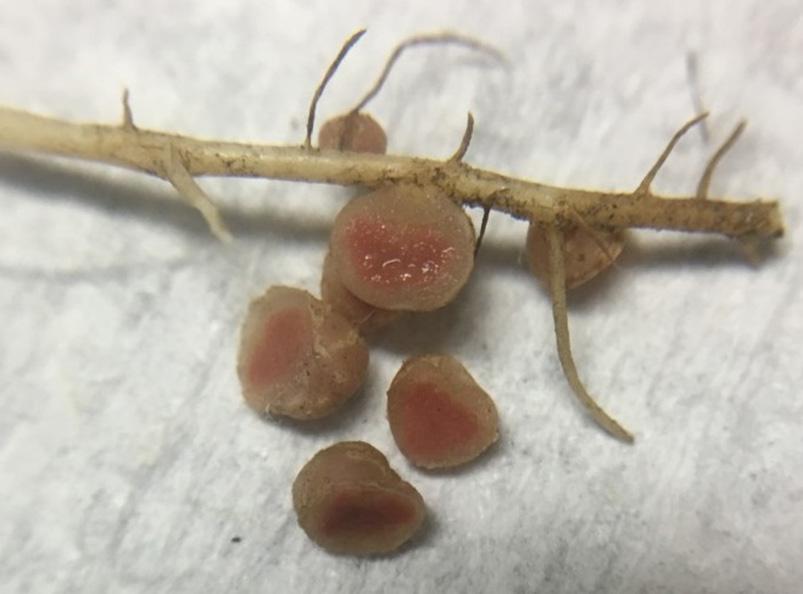



Flavia Zambon
Established in 2019-2020 at the UF/IFAS Indian River Research and Education Center in Fort Pierce, the Millennium Block remains a cornerstone of grapefruit research in Florida’s production region. Hosting over 5,500 trees, this large-scale trial continues to yield valuable insights into huanglongbing (HLB)-tolerant varieties. Notably, some combinations produce industry-grade fruit under standard grower care practices, without the need for OTC injections.
The research consists of four independent trials focused on scion-rootstock performance:
• Trial 1: 18 grapefruit scions grafted onto 3 rootstocks
• Trial 2: ‘Ray Ruby’ grapefruit grafted onto 31 distinct rootstocks
• Trial 3: ‘Glen F-56-11’ Navel orange grafted onto 31 rootstocks
• Trial 4: ‘UF-950’ Mandarin grafted onto 31 rootstocks

Each trial evaluates fruit quality, yield, and adaptability under HLB-endemic conditions. Six years into the study, the trees are providing critical data on varietal resilience. Harvest typically begins in mid-November, after the Millennium Block Field Day, and continues through mid-February.
A key part of the evaluation process is separating “good fruit” from “bad fruit” in the field before bin transport. “Good fruit” reflects healthy varietal traits such as


uniform color, shape, and size. In contrast, green, immature, or diseased fruit is categorized as “bad,” then weighed, and discarded. Only “good fruit” is used for quality assessments and performance analyses.
Though the 2024-25 season brought challenges— including an EF-3 tornado from Hurricane Milton— several promising outcomes emerged. The ‘Triumph’ grapefruit-orange hybrid retained fruit well despite the storm, and juice quality across many varieties remained strong. Most combinations in Trial 1 exceeded 7 °Brix, with ‘Triumph’ and ‘UF-914’ averaging above 9 °Brix.
For the 2025-26 season, all combinations will undergo a pre-harvest fruit quality check in September to verify °Brix accumulation prior to color break. This analysis helps determine which varieties will be harvested early (by December) versus those that will be harvested later (January-February).
Yield for ‘Triumph’ declined from 227 boxes per acre in 2023-24 to 92 in 2024-25. Historical data suggests potential mild alternate bearing behavior. It remains unclear whether pruning and canopy management influence flowering and fruit set in mature ‘Triumph’ trees. Similarly, the ‘UF-914’ pummelo hybrid experienced lower yields across Sour Orange, US942, and X-639 rootstocks, although fruit quality stayed high.
For the second consecutive year, UFR-15 has proven to be the leading rootstock for ‘Ray Ruby,’ delivering nearly 60 boxes per acre and consistently exceeding 7 °Brix. UFR-11 produced an impressive 8.5 °Brix, though with elevated acidity.
Trial 3’s Glen Navels were among the varieties most affected by the tornado in 2024, yielding a maximum of 17 boxes per acre when grafted onto US-812. Additionally, a pronounced June drop in navel oranges will impact the 2025–26 yield. In Trial 4, mandarins
continue to face fruit retention challenges, exacerbated by funding limitations that disrupted planned gibberellic acid applications.
Looking ahead, we remain hopeful that ‘Triumph’ will rebound in productivity, offering a valuable case study in alternate bearing, and that °Brix values – especially for ‘UF-914’ – will remain high.
In the face of the setbacks faced in 2024, the resilience of certain varieties underscores the importance of thoughtful scion and rootstock selection for new plantings. By continuously refining management strategies, growers can sustain fruit quality and yield amid persistent HLB pressure.
The Millennium Block also serves as a hub for collaboration. Each year, we welcome visitors, industry partners, and researchers who contribute to this evolving project. Currently, three research teams are actively collecting data, and additional groups are expressing interest in exploring the block’s unique attributes. The knowledge gained at the Millennium Block lights the way forward, helping to ensure the adaptability and sustainability of Florida’s citrus industry.

Pummelo-hybrid fruit during the 2024-25 harvest.
Dr. Flavia Zambon - UF/IFAS IRREC
Can you briefly describe your current research in simple terms?
My current citrus research involves a comprehensive investigation of HLB tolerance in various scions and rootstocks at two large-scale trials that consist of over 17,000 trees.
What question or problem are you most passionate about solving?
My passionate question is: ‘why’. I believe that without this question, we wouldn’t be achieving breakthroughs in science. In my research context, it is a ‘why do the plants respond differently to an input, or disease, or environmental condition?’
What’s a discovery or project you’re especially proud of?
I am proud of my Ph.D. research with Dr. Grosser at UF/ IFAS CREC, which has shown that manganese has a therapeutic effect on the multiplication of Candidatus Liberibacter in field-established mature sweet orange trees. The other was the surprising discovery of HLB-tolerant trees, ‘Triumph’ and ‘UF-914’, at the Millennium Block.
How has your research evolved over time?
My research does not involve selecting beautiful trees, it focuses on choosing productive ones. Therefore, my research has evolved by adding more questions to the main objectives with each discovery, whether big or small.
What’s the most exciting part of your work?
The feedback on current projects whether it comes from an industry partner, a collaborator, a grower, or other peers. Additionally, I am excited to be part of the new scientific generation that will pave the way for the ones I am mentoring.
How do you come up with new ideas or hypotheses?
I brainstorm a lot with my team and colleagues. I also keep my paper reading in check, both in my research focus and in other areas that can be adapted to horticulture. I also ask people in horticulture production what problems, challenges, or innovation gaps they are facing and where I can assist.
What tools or techniques are essential to your work?

I can’t do my work without my truck, my physiology equipment, a good magnifying glass, and a trained team to do disease index rating on the 17,000 trees we evaluate. Also, a dose of persistence and an AI calendar manager.
What’s the weirdest or most unexpected thing that’s happened during your research?
When a grower and I saw the ‘Triumph’ trees in the Millennium Block in 2023. We looked at each other, and said: ‘wait a minute, this group is drastically different from the next one’ (the next one was the red grapefruit that should’ve been planted instead of ‘Triumph’). This was definitely unexpected, and it added another focus to the research conducted at the Millennium Block.

Credit: Robin Koestoyo, UF/IFAS
Learn more about Flavia here: https://go.ufl.edu/fzambon
Tripti Vashisth and Taylor Livingston
Excessive pre-harvest fruit drop caused by huanglongbing (HLB) remains a major concern for Florida’s citrus industry, especially with the increased hurricane activity over the past eight years, including Irma (2017), Ian (2022), and Milton (2024). Physical stress from hurricanes can cause massive fruit loss, sometimes not immediately, but rather a month or more after a storm. Other stressors, such as water or nutrient deficits, freezing temperatures, and flooding, can also accelerate fruit drop and contribute to faster tree decline.
Abscission is the natural process where fruit separates from the stem, leading to fruit drop. Vascular tissue in the stem delivers water and carbohydrates to the fruit. When the abscission zone forms, this vascular connection is severed, and cell wall breakdown allows the fruit to detach. In HLB-affected trees, this process begins earlier and proceeds more rapidly.
Field studies in Florida have shown that applications of plant growth regulators (PGR) can reduce pre-harvest fruit drop in sweet orange.
Gibberellic acid (GA) has become widely used in the Florida citrus industry. When applied at the correct time and rate, GA increases yield, reduces fruit drop, and helps maintain canopy health in both ‘Valencia’ and ‘Hamlin’. GA is not thought to directly stop fruit drop; but, rather, it delays peel senescence (aging), which indirectly reduces fruit drop. Research is ongoing to better understand GA’s exact mechanisms.
Auxins, another class of PGRs, are directly involved in the abscission process. As fruit senesce, auxin levels decrease rapidly, triggering internal signals for abscission. Applying auxins such as 2,4-D replenishes this loss and helps reduce fruit drop. HLB-induced fruit drop may also be linked to increased ethylene levels, a gaseous hormone that promotes abscission, which are elevated in HLB-affected citrus. Both GA and auxins can counteract ethylene’s effect.
HLB-affected trees often respond better to frequent, smaller applications of fertilizer and water. So would this also work with PGRs? Past research has shown GA applications have a compounding effect, the more applications there are in a season, the greater the response. To test whether a similar approach
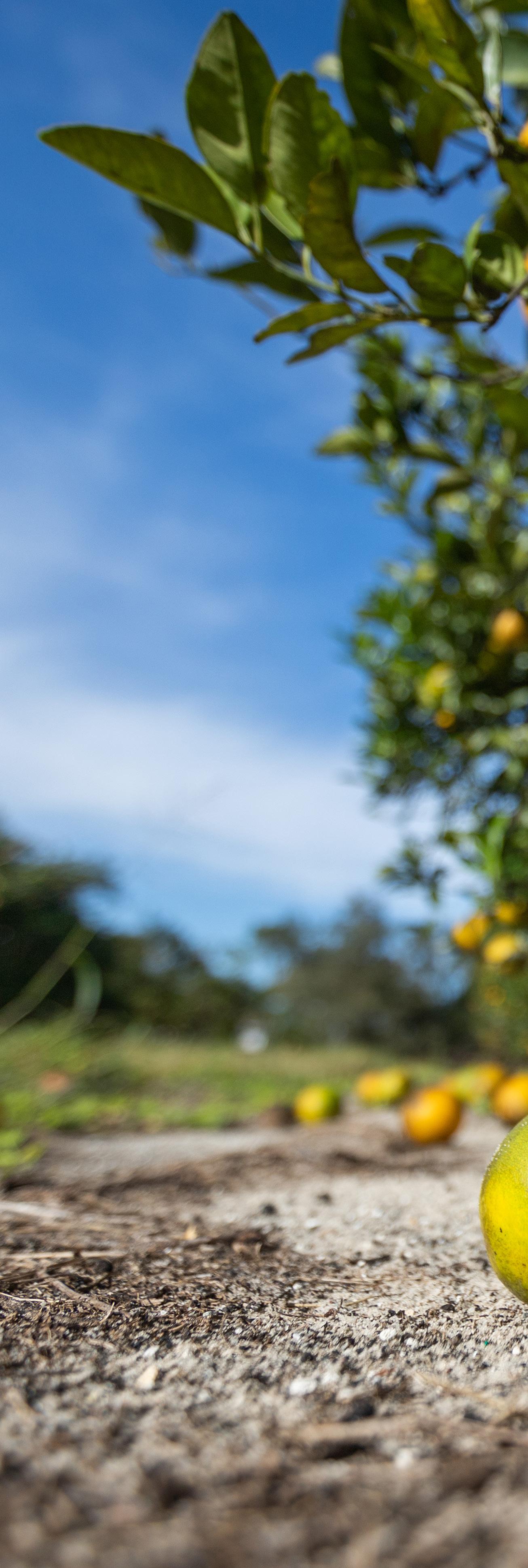
“GA
and 2,4-D work through different mechanisms, providing a complementary ‘dual-action’ approach to reducing fruit drop.”


works for auxins, a field trial began in 2023 in Polk County, Florida, on mature (15+ year old) ‘Valencia’ trees on Swingle rootstock to compare multiple low dose applications of 2,4-D on HLB-affected trees using Citrus Fix (AMVAC Chemical) as the auxin source and ProGibb LV plus ( Valent Biosciences).
Treatments included:
1. Untreated Control (no spray at all)
2. 3.2 oz/acre 2,4-D in November (label rate)
3. 1 oz/acre 2,4-D in September, October,and November
4. 3.2 oz/acre 2,4-D + 10 oz GA (ProGibb LV plus) in November
All treatments included a nonionic surfactant (Induce, Helena Agri-Enterprises) at the label rate at 0.15% spray volume. Hurricane Milton struck between year one and two of the study, influencing fruit yield in year two.


In year one, the 3.2 oz 2,4-D + GA treatment had significantly less fruit drop than the control, averaging 16% less drop overall. In year two, when drop was higher across all treatments due to hurricane stress, both the 3.2 oz 2,4-D + GA and the 3.2 oz 2,4-D alone treatments significantly reduced fruit drop compared to the control (Figure 1).
Fruit yield did not differ significantly in year one. In year two, when yield was normalized by canopy size (yield efficiency), all treatments performed significantly better than the control (Figure 2). The 3.2 oz 2,4-D + GA treatment produced the highest yield efficiency and significantly higher total yield than the control. Since the yield in year 2 was negatively affected by Hurricane Milton, it’s evident that any intervention using 2,4-D whether by itself or ideally with GA, helps in reducing fruit drop and improving yield.
The more frequent low-dose 2,4-D application (1 oz/ acre, three times) did not reduce fruit drop in either year, indicating that the single November application at the label rate is sufficient for reducing fruit drop in ‘Valencia’. Results were enhanced when GA was added to the tank.
This study reinforces that a targeted GA + 2,4-D program can help maintain fruit yield in HLB-affected sweet orange, even under severe weather pressure.
• A single 3.2 oz/acre application of 2,4D in November effectively reduced fruit drop in ‘Valencia’.
• Adding GA to the November 2,4-D application enhances results, even in the first year.
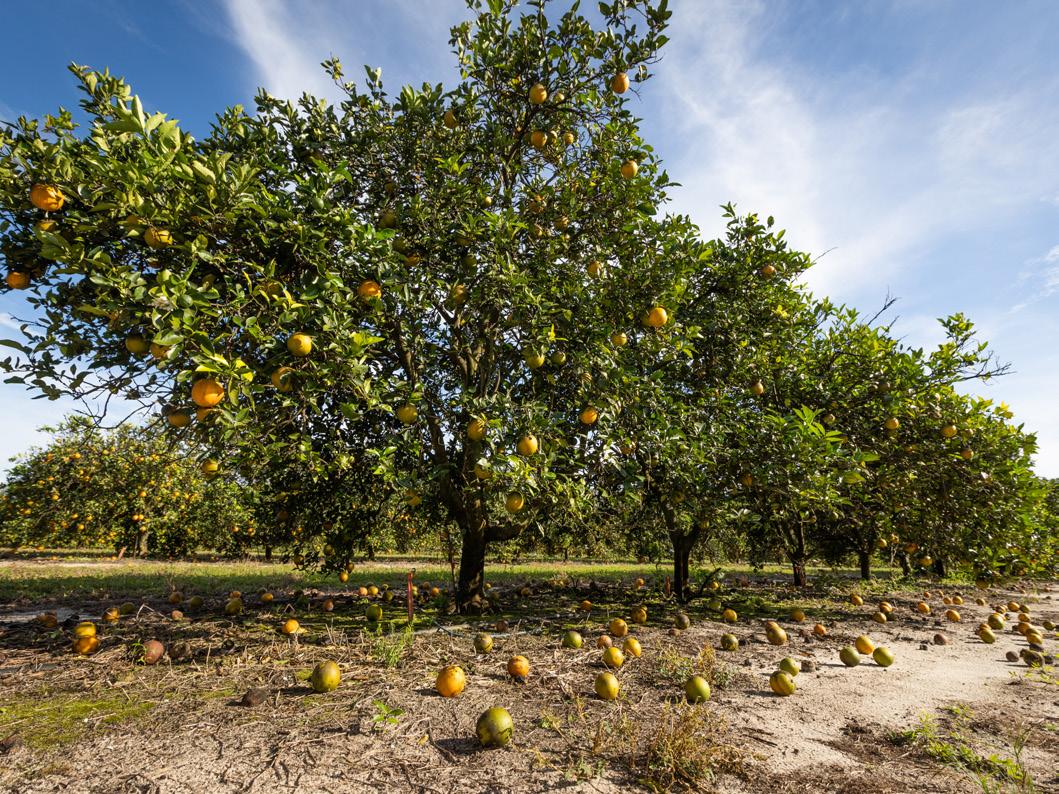
John Chater
• ‘Hamlin’ N13-32 sweet orange is a relatively new budline of ‘Hamlin’. It was developed from a somaclone of conventional ‘Hamlin’, selected by Dr. Jude W. Grosser from a trial of 500 different somaclonally-derived ‘Hamlin’ individuals.
• The harvest date of ‘Hamlin’ N13-32 is estimated to be about two weeks earlier than that of conventional ‘Hamlin’.
• In HLB-affected environments, ‘Hamlin’ N13-32 exhibits improved tree health, including a denser canopy, reduced branch dieback, and faster tree growth across multiple locations when compared to conventional ‘Hamlin’.
• Six-year-old trees can produce up to 1.3 boxes per tree, with an average yield of one box per tree.
• Fruit quality is comparable to conventional ‘Hamlin’. Packinghouse data indicate a packout rate of approximately 50%, with an average of 9.5
°Brix and ratio up to 17.3 when harvested during the first week of November.


• X-639 is a rootstock originally sourced from South Africa and imported into Florida, first becoming available in 1994. Developed in the 1950s, it is a hybrid of C. reshni ‘Cleopatra’ and Poncirus trifoliata.
• In Florida, X-639 shows tolerance to Phytophthora and citrus tristeza virus (CTV) and performs relatively well under moderate soil salinity conditions.
• This rootstock has proven to be a strong choice for various citrus cultivars in HLB-affected environments. Over the past three years, it has consistently ranked among the top three rootstocks selected by growers and was the sixth-most propagated rootstock in 2023-2024.
• X-639 typically produces a relatively larger tree. For optimal grove performance, an in-row spacing of 8 to 12 feet is recommended.
Ariel Singerman
In past years, I have argued that insuring the citrus crop under the Actual Production History (APH) policy would likely be beneficial for most Florida citrus growers. This is because the policy provides coverage against yield losses based on the farm’s historical yield records. Given the continued negative impact of huanglongbing (HLB) on Florida citrus yield, and the policy’s reliance on past records, the policy’s guarantees are set higher than what they would otherwise be if the downward trend caused by the disease were considered. In fact, in an article published last year, using data for 2021/22 and 2022/23 I showed that, on average, orange growers in Florida were not only more likely to receive an indemnity when obtaining coverage under the APH policy relative to the Dollar Amount policy but also received a higher level of indemnity payment when doing so. Going forward, the question becomes whether APH will continue to be advantageous for Florida citrus growers. As I will explain throughout the rest of this article, the answer is: “it depends”.
Building the Foundation
Recall that the basis for establishing the guarantee (or liability) and premium under APH is called the APH yield, which consists of averaging the farm’s yield records for the last 10 seasons (which constitutes the APH database). Regarding the price that is used to establish the premium and guarantee amounts, it is set by the Federal Crop Insurance Corporation (FCIC). Growers can elect to insure at a lower price or, alternatively, can provide a contract price, if available. APH coverage levels range from 50% to 85% in 5% increments. At the time of enrollment, the grower chooses a certain coverage level, which combined with the APH yield determines the guarantee and the deductible (the amount of loss for which the grower will not receive an indemnity). Any actual level of yield below the guarantee will trigger an indemnity.
Also recall that the Risk Management Agency (RMA)’s standards include a procedure for testing high variability in yields to determine whether any adjustments to the APH database are warranted, either due to alternate bearing (common for ‘Valencia’ oranges) or downward trend patterns. A test for a downward trend on the grower’s APH database is triggered when two conditions are met. For example, in a database containing records for 10 years, the conditions are that
(1) in at least four out of the ten previous seasons the yield was below 75% of the APH yield, and (2) at least one of those seasons was among the last three. When both conditions are met, the downward trend test is conducted. However, the downward trend adjustment is only implemented if the average yield for the last three seasons is less than 75% of that of the APH database. Should that be the case, the APH yield will be reduced by 20%. Importantly, given the impact of Hurricane Ian on citrus production in Florida during 2022/23, the RMA instructed insurance companies to exclude that crop year from high variability tests calculations. Due to the impact of Hurricane Milton, 2024/25 may likewise be excluded from the calculations but this has not yet been established.
As Florida citrus yield continues to be negatively impacted by the combination of HLB and weather shocks, it is important to keep in mind another requirement for acreage to be insurable under APH: blocks that are at least eight years old must have produced at least 100 boxes per acre in at least one of the three previous seasons (there is an ongoing discussion that may lower the requirement to 75 boxes per acre). Should a grower have a block not meeting such a requirement, a request may be submitted to the RMA regional office to be able to obtain APH coverage. However, in such cases, the determined yield may not exceed 80% of the average yield for the entire APH database
“The
net indemnities from APH are decreasing over time because APH yield is decreasing and the premium rates are increasing.”
To illustrate under what conditions APH will continue to be advantageous for Florida citrus growers to insure their crops, I use Polk County yield records for ‘Valencia’ oranges as an example because I do not have any farmlevel yield data available. Using the county’s average yield, I estimate Polk County APH yield in 2024/25 to be 158 boxes per acre. The FCIC established the price for ‘Valencia’ oranges for 2025 to be $12.29 per box. While the actual yield for the current season is still unknown (at least to me), groves impacted by Hurricane Milton
are unlikely to achieve yields higher than those attained in the previous season. In contrast, groves that avoided significant hurricane damage and received oxytetracycline trunk injections may experience higher yields. But in either case, the (average) yield in Polk County will most likely be below the guarantee resulting from the combination of the coverage level chosen and the APH yield of 158 boxes per acre. For example, the indemnity for 50%, 60%, 70%, and 80% coverage will be positive if yield turns out to be less than the corresponding guarantee of 79, 95, 111, 126 boxes per acre, respectively.
Figure 1 shows the 2024/25 estimated net indemnity (that is, indemnity minus premium) from APH by coverage for levels of yield that range from 60 to 130 boxes per acre using Polk County yields for ‘Valencia’ oranges as an example. The figure illustrates the net indemnity at each coverage level. So, for example, under 50%, 60%, 70%, and 80% coverage, if yield is 70 boxes per acre, the net indemnity per acre will be $107, $296, $473, $612, respectively. Figure 1 also shows that the net indemnity from APH will be negative and, at most, equal to the premium if yield turns out to be higher than the corresponding guarantee under each coverage level.
To estimate APH indemnities in Polk County for 2025/26, I need to estimate the county’s 2025/26 APH yield, which turns out to be 145 boxes per acre. The FCIC established the price for ‘Valencia’ oranges for 2026 to be $13.07 per box. In addition, the premium rates for 2026 are already available, so I can combine the previous information to estimate the indemnity payments. Thus, for example, the indemnity for 50%, 60%, 70%, and 80% coverage will be positive if yield in 2026 will turn out to be less than the corresponding guarantee of 72, 87, 101, 116 boxes per acre, respectively.
Figure 2 shows the estimated net indemnities from APH in 2025/26 by coverage for levels of yield that range from 60 to 130 boxes per acre using, again, Polk County yields for ‘Valencia’ oranges as an example. Thus, for example, under 50%, 60%, 70%, 80% coverage, if yield turns out to be 70 boxes per acre, the net indemnity per acre will be $21, $209, $368, $493, respectively. It is worth noting that the calculations in my example for Polk County yields in 2025/26 met the requirement of having the minimum number of boxes per acre
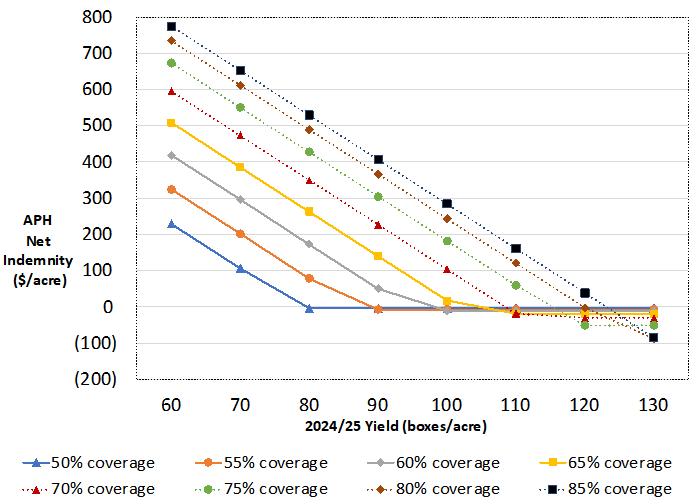


Example of estimated net indemnity from APH by coverage for levels of ‘Valencia’ orange yield that range from 60 to 130 boxes per acre using Polk County as an example.
UF/IFAS Extension Highlands County
4509 George Blvd, Sebring, FL 33875
•
Hosted by the UF/IFAS Citrus Team
•
Join us for sessions with the experts and demonstrations.

in at least one out of the last three previous seasons and did not meet the conditions for conducting a test for a downward trend on the APH database. Therefore, the APH yield is not reduced by 20%. But, individual growers may want to make the calculations for their own groves so as to choose the optimal level of coverage.
To obtain an estimate of the APH payouts in Polk County in 2027, I need to first estimate what will be the county’s yield in 2024/25 to then be able to estimate the county’s 2026/27 APH yield. Given the impact of Hurricane Milton, I assume that the ratio of yield in Polk County to that of the state average in 2024/25 will be similar to that in 2017/18 (when Hurricane Irma occurred). Thus, I estimate that Polk County yield in 2024/25 will be 64 boxes per acre (which turns out to be the same county yield as in 2023/24). Using such a figure, Polk County’s APH yield in 2026/27 turns out to be 132 boxes per acre. Importantly, however, the requirement for having 100 boxes per acre in at least one out of the last three previous seasons is not met in my example for Polk County (note the requirement would not be met even if it were lowered to 75 boxes per acre). Therefore, the county’s 2026/27 APH yield will be reduced by 20% and becomes 105 boxes per acre.
Given that the APH yield will be reduced, so will the guarantees. Thus, for example, for 50%, 60% 70%, 80% coverage the corresponding guarantees will be
53, 63, 74, and 84 boxes per acre. I assume that the FCIC price for ‘Valencia’ oranges for 2027 will increase by the same percentage as it did in the previous two seasons, so it will be $13.90 per box. Using updated values for the RMA premium rates, I can combine all of the previous information to estimate the net indemnity from APH in 2026/27 by coverage for different levels of yield, again, using Polk County yield records as an example (Figure 3).
The figure illustrates the net indemnity at each coverage level. So, for example, under 50%, 60%, 70%, and 80% coverage, if yield in 2027 were to be 70 boxes per acre, the net payout per acre will be $19, $64, $90, $104. Note how significantly smaller those estimates are compared to those in the previous two seasons. Figure 3 also shows that the net indemnity from APH will be negative and, at most, equal to the premium (as high as $174 per acre for the 85% coverage level) if yield turns out to be higher than the corresponding guarantee under each coverage level.
Obtaining coverage under the APH policy has, on average, been economically beneficial for Florida citrus growers so far. This is largely because the policy provides coverage against yield losses based on historical farm yield records, resulting in higher guarantees relative to what they would otherwise be if the downward trend in yield caused by HLB were considered. In 2024/25, on average, growers will likely continue to obtain a positive payout from having insured their crop under APH coverage. That may also be the case in 2025/26 if yield that season is below the grower’s guarantee and his APH database does not trigger the reduction either due to the downward trend test or the requirement to produce a minimum number of boxes per acre in one of the three most recent seasons. However, it is important to note that the net indemnities from APH are decreasing over time. This is due to both increasing premium rates and decreasing yield as well APH yield. By 2026/27, it is possible that some blocks will fail to meet the RMA requirement of producing the required minimum number of boxes per acre in one of the three most recent seasons. If that happens, the grower’s APH yield would be reduced by 20%, which, in turn, will make any potential APH indemnities significantly smaller, if any. Therefore, individual growers may want to make their own calculations so as to choose the optimal level of APH coverage for their groves.
• Rainy season supports citrus growth but brings hurricane threats (June 1 - November 30).
• Hurricanes can cause wind damage, flooding, and saltwater intrusion.
• Severe damage includes fruit drop, uprooted trees, and suffocated roots.
• Quick replanting and water removal within 72 hours are critical.
PLANNING AND PREPARATION
Timing
• Develop hurricane plans ahead of time
• Hurricanes peak in August and September. Plan Goals
• Protect people, equipment, and recovery resources.
• Maintain adequate insurance coverage.
Resources
• Local Emergency Management, Sheriff, Chamber of Commerce, and Economic Development offices.
PRE-STORM PREPARATION
Personnel Assignments
• Assign duties for pre-, during, and post-storm.
• Set up damage inspection and repair teams.
• Maintain contact info for all workers.
Safety Training
• Train workers on equipment like chainsaws.
Liquid Tanks
• Keep full to prevent movement and ensure availability.
Ditches
• Keep clean and drained for post-storm water removal.
Cultural Practices
• Prune trees regularly to reduce breakage.
• Use windbreaks to reduce canker spread and damage.
Emergency Equipment
• Ensure availability and maintenance of generators, chainsaws, and compressors.
• Rent diesel generators (25-60 kW) during hurricane season.
Communications Equipment
• Ensure radios and cell phones work.
• Use hand-held radios with spare batteries for field workers.
Hazardous Materials
• Secure all hazardous substances.
• Shut down gas pumps. Emergency Contacts
• List important numbers (utilities, sheriff, medical, etc.).
Activity Checklist
• Prioritize block-by-block recovery plan. Employee Call-In
• Have updated contact list for quick mobilization. Damage Inspection
• Use trucks or aerial services (helicopter) for grove survey. Clear Road Access
• Remove debris to allow equipment and personnel access. Water Removal
• Drain water from root zones within 72 hours. Tree Rehabilitation
• Upright toppled trees quickly.
• Use pruning saws, loaders, and backhoes.
• Paint exposed wood to prevent sunburn.
• Regular pruning is the best pre-storm protection.
• Post-storm, quickly:
• Clear debris.
• Repair irrigation.
• Reset and protect trees.
• Fertilize and irrigate frequently for recovery.
Adapted from UF/IFAS HS-804 https://go.ufl.edu/hurricaneprep
Credit: Tonya Weeks, UF/IFAS
Damage after Hurricane Milton at UF/IFAS CREC.

Madelyn Greathouse Sumter, Pasco, and Hernando Counties mgreathouse@ufl.edu
Edwin Gutierrez DeSoto, Hardee, and Manatee Counties edwingr@ufl.edu
Ute Albrecht ualbrecht@ufl.edu
Fernando Alferez alferez@ufl.edu
Yiannis Ampatzidis i.ampatzidis@ufl.edu
Ozgur Batuman obatuman@ufl.edu
Bryony Bonning bbonning@ufl.edu
Stephanie Brown stephaniebrown@ufl.edu
Michael Burton burton.m@ufl.edu
Liliana Cano lmcano@ufl.edu
José Chaparro jaguey58@ufl.edu
John Chater jchater@ufl.edu
Michelle Danyluk mddanyluk@ufl.edu
Megan Dewdney mmdewdney@ufl.edu
Lauren Diepenbrock ldiepenbrock@ufl.edu
Larry Duncan lwduncan@ufl.edu
Alissa Hevesh Highlands County ahevesh@ufl.edu
Chris Oswalt Hillsborough and Polk Counties wcoswalt@ufl.edu
Manjul Dutt manjul@ufl.edu
Choaa El Mohtar mohtarc@ufl.edu
Svetlana Folimonova svetlana@ufl.edu
Dean Gabriel dgabr@ufl.edu
Fred Gmitter fgmitter@ufl.edu
Claudio Gonzalez cfgonzalez@ufl.edu
Jude Grosser jgrosser@ufl.edu
Sandra Guzmán sandra.guzmangut@ufl.edu
Davie Kadyampakeni dkadyampakeni@ufl.edu
Ramdas Kanissery rkanissery@ufl.edu
Nabil Killiny nabilkilliny@ufl.edu
Mark Kistler mark.kistler@ifas.ufl.edu
Amit Levy amitlevy@ufl.edu
Graciela Lorca glorca@ufl.edu
Amir Rezazadeh St. Lucie County amir2558@ufl.edu
Matt Smith Lake and Orange Counties smith197@ufl.edu
Danielle Williams Gadsden County dsprague@ufl.edu
Mongi Zekri Charlotte, Collier, Glades, Hendry, and Lee Counties maz@ufl.edu
Xavier Martini xmartini@ufl.edu
Kimberly Morgan kimorgan@ufl.edu
Zhonglin Mou zhlmou@ufl.edu
Taylor O’Bannon taylorlangford@ufl.edu
Ahmad Omar omar71@ufl.edu
Dean Pringle td.pringle@ufl.edu
Nicole Quinn nicole.quinn@ufl.edu
Jawwad Qureshi jawwadq@ufl.edu
Mark Ritenour ritenour@ufl.edu
Michael Rogers mrgrs@ufl.edu
Arnold Schumann schumaw@ufl.edu
Muhammad Shahid mshahid@ufl.edu
Ariel Singerman singerman@ufl.edu
Kirsten Pelz-Stelinski pelzstelinski@ufl.edu
Lukasz Stelinski stelinski@ufl.edu
Sarah Strauss strauss@ufl.edu
Eric Triplett ewt@ufl.edu
Nikolaos Tziolas ntziolas@ufl.edu
Tripti Vashisth tvashisth@ufl.edu
Christopher Vincent civince@ufl.edu
Tara Wade tara.wade@ufl.edu
Nian Wang nianwang@ufl.edu
Yu Wang yu.wang@ufl.edu
Alan Wright alwr@ufl.edu
Flavia Zambon f.zambon@ufl.edu



Scan QR code for a digital version.